Abstract
Nonstained bacteria (NSB), rhodamine-stained bacteria (RSB), and fluorescence-labeled bacteria (FLB) were prepared from two enteric bacterial species, Escherichia coli and Enterococcus faecalis. Counts of CFU of NSB and RSB and total numbers of RSB and FLB were monitored over time, both in the presence and in the absence of natural microbiota. In the presence of natural microbiota, no differences were observed between CFU counts of NSB and RSB, but RSB total numbers were 1 to 4 orders of magnitude higher than CFU numbers. Therefore, the use of standard bacteriological media causes an important underestimation of the total number of enteric bacteria. In the absence of natural microbiota, the total numbers of NSB, RSB, and FLB remained constant over time. These results showed that RSB are a reliable indicator of the decay in both the total number and the CFU of enteric bacteria in natural water samples. By using RSB, enteric bacteria were classified as culturable cells, nonculturable cells (or somnicells), and dead cells in the presence of natural microbiota. In the presence of natural microbiota, differences between RSB and FLB direct counts were detected for E. coli, but not for E. faecalis. These differences were explained by size-selective grazing. Thus, protistan grazing was found to be the main cause of the decrease in total numbers of enteric bacteria in our experiments.
Full text
PDF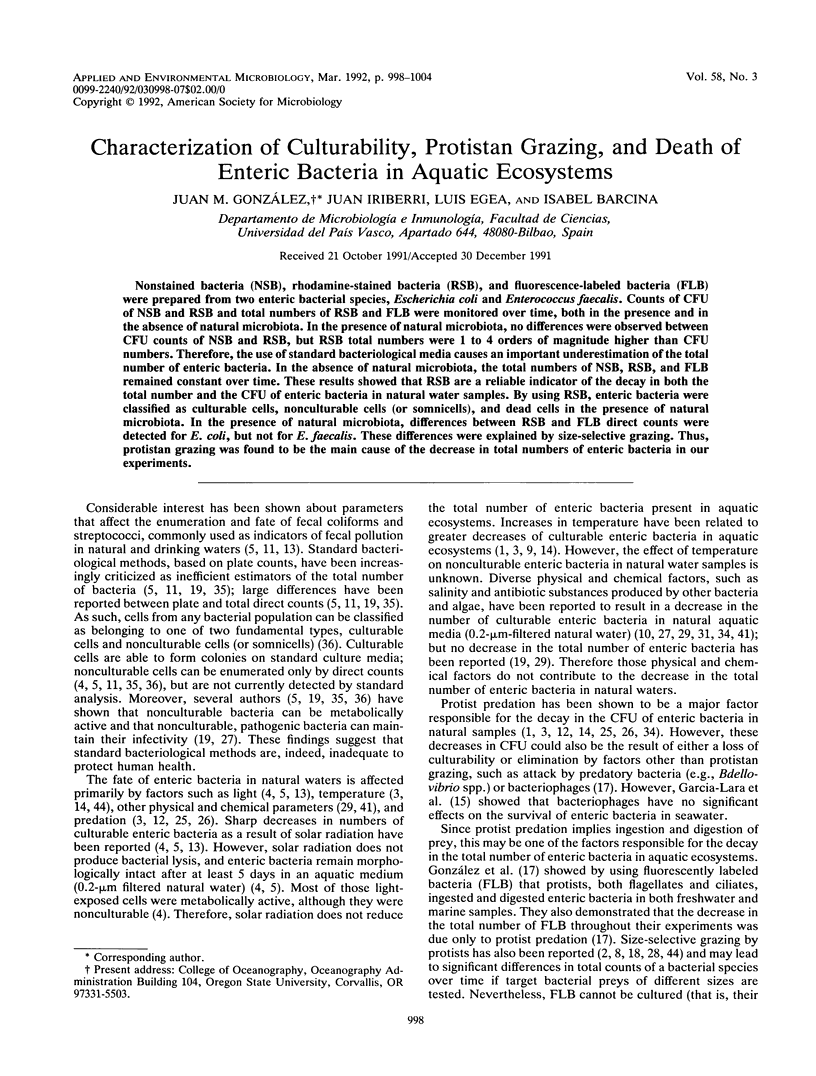
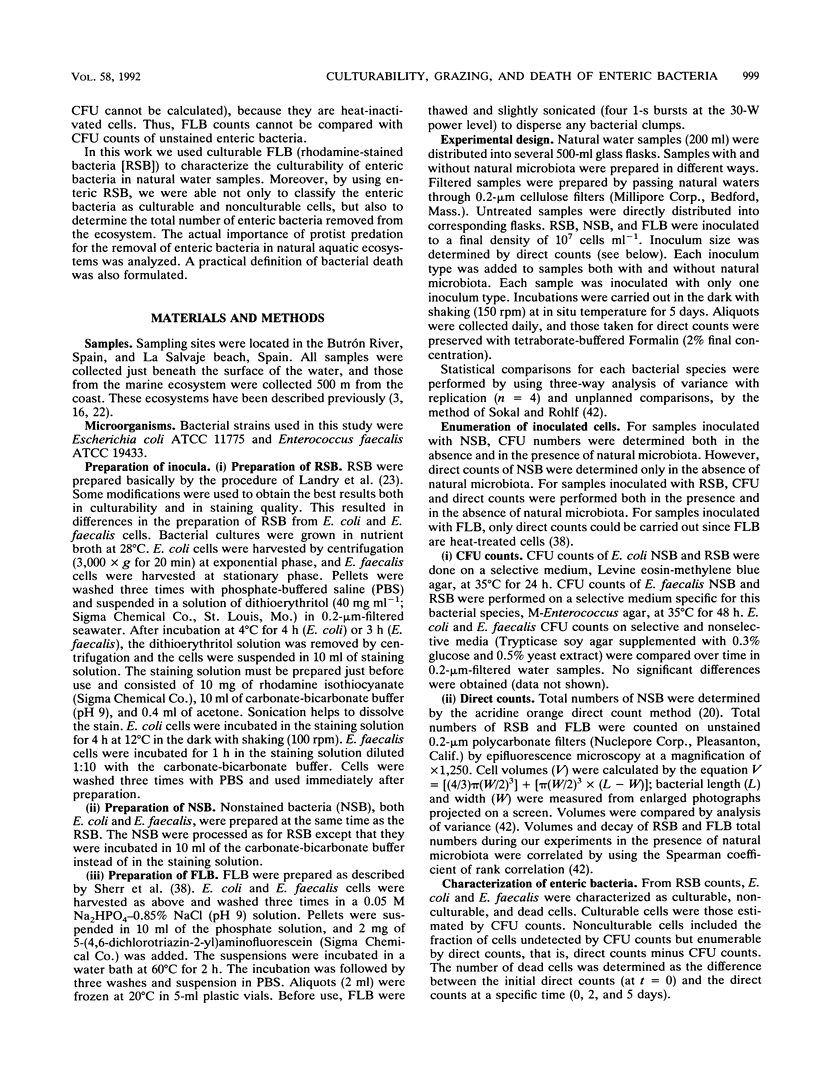

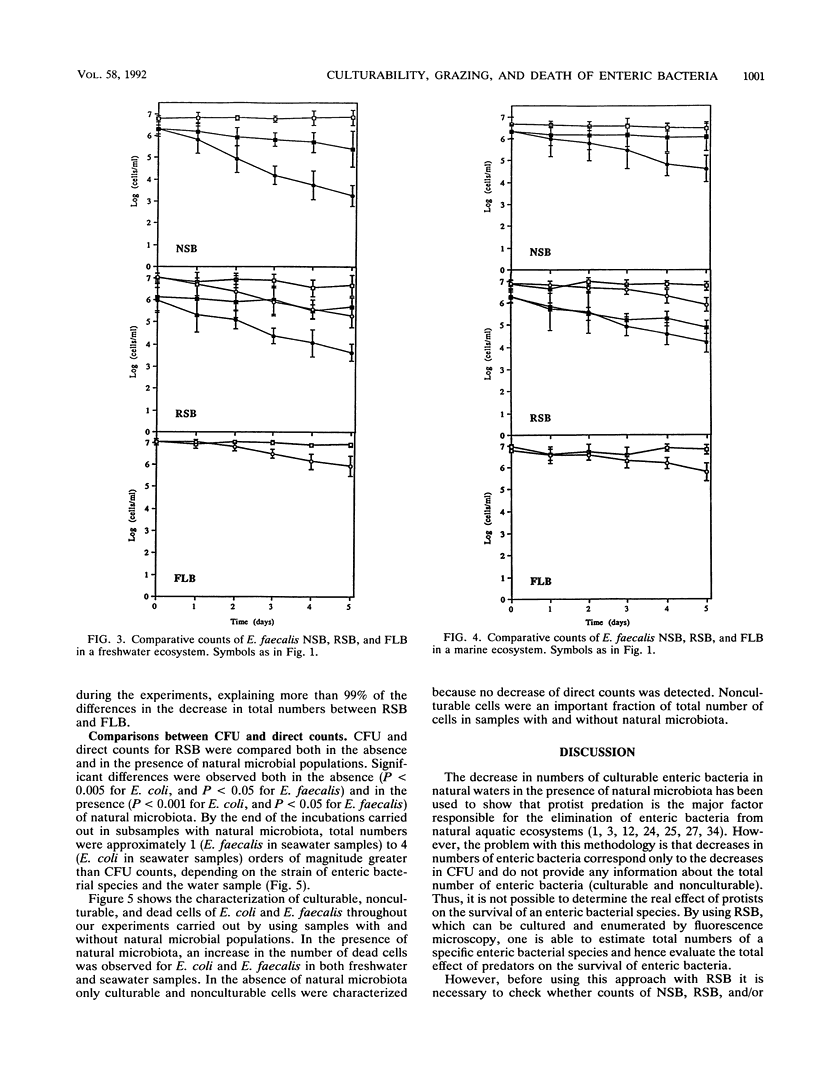
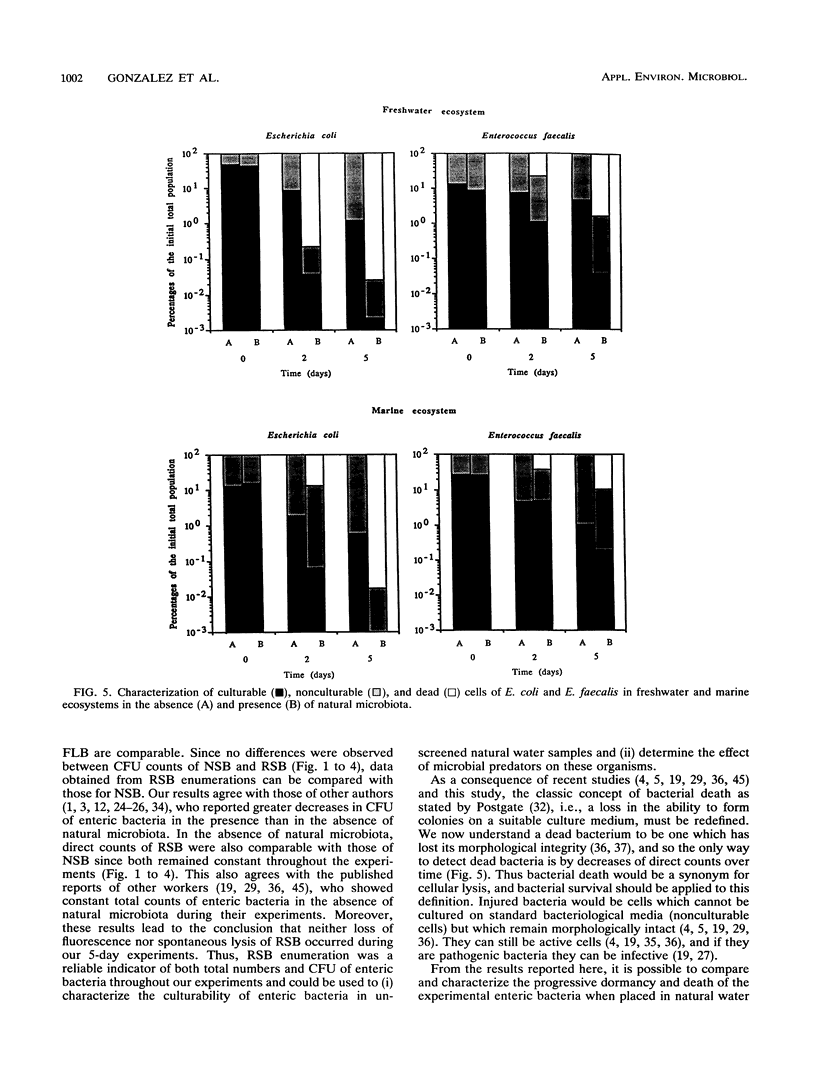
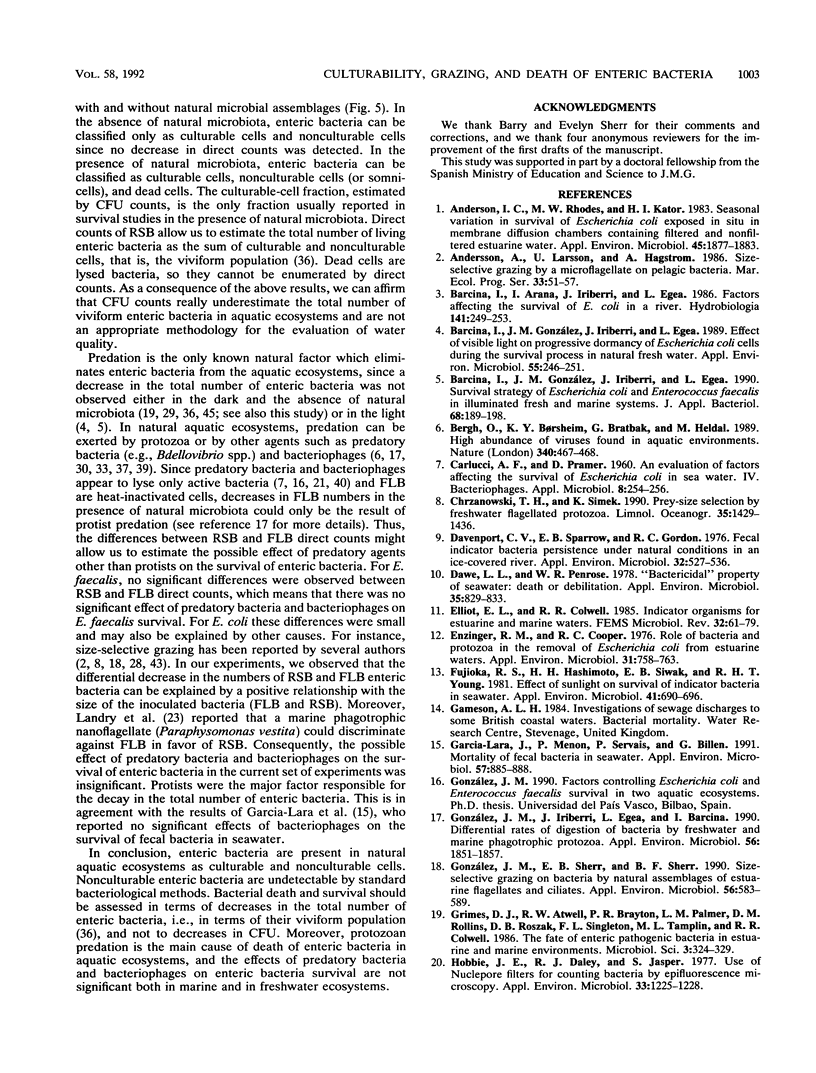
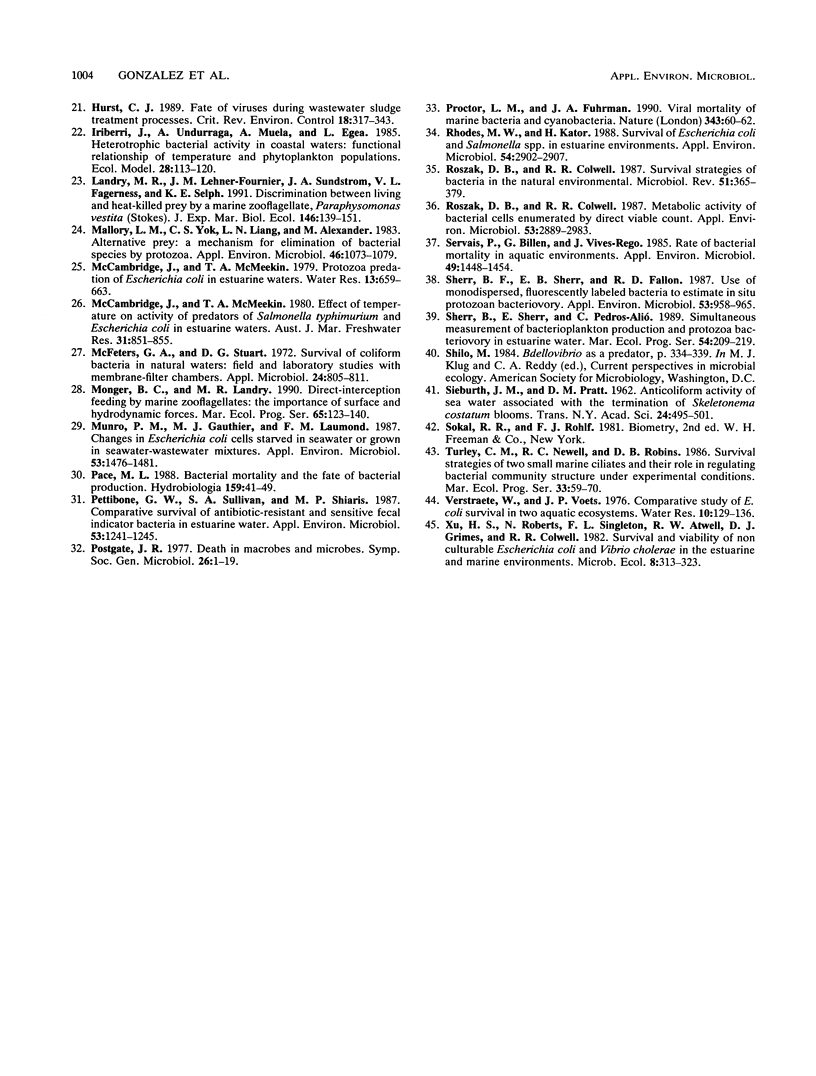
Selected References
These references are in PubMed. This may not be the complete list of references from this article.
- Anderson I. C., Rhodes M. W., Kator H. I. Seasonal variation in survival of Escherichia coli exposed in situ in membrane diffusion chambers containing filtered and nonfiltered estuarine water. Appl Environ Microbiol. 1983 Jun;45(6):1877–1883. doi: 10.1128/aem.45.6.1877-1883.1983. [DOI] [PMC free article] [PubMed] [Google Scholar]
- Barcina I., González J. M., Iriberri J., Egea L. Effect of visible light on progressive dormancy of Escherichia coli cells during the survival process in natural fresh water. Appl Environ Microbiol. 1989 Jan;55(1):246–251. doi: 10.1128/aem.55.1.246-251.1989. [DOI] [PMC free article] [PubMed] [Google Scholar]
- Barcina I., González J. M., Iriberri J., Egea L. Survival strategy of Escherichia coli and Enterococcus faecalis in illuminated fresh and marine systems. J Appl Bacteriol. 1990 Feb;68(2):189–198. doi: 10.1111/j.1365-2672.1990.tb02565.x. [DOI] [PubMed] [Google Scholar]
- Bergh O., Børsheim K. Y., Bratbak G., Heldal M. High abundance of viruses found in aquatic environments. Nature. 1989 Aug 10;340(6233):467–468. doi: 10.1038/340467a0. [DOI] [PubMed] [Google Scholar]
- CARLUCCI A. F., PRAMER D. An evaluation of factors affecting the survival of Escherichia coli in sea water. IV. Bacteriophages. Appl Microbiol. 1960 Jul;8:254–256. doi: 10.1128/am.8.4.254-256.1960. [DOI] [PMC free article] [PubMed] [Google Scholar]
- Davenport C. V., Sparrow E. B., Gordon R. C. Fecal indicator bacteria persistence under natural conditions in an ice-covered river. Appl Environ Microbiol. 1976 Oct;32(4):527–536. doi: 10.1128/aem.32.4.527-536.1976. [DOI] [PMC free article] [PubMed] [Google Scholar]
- Dawe L. L., Penrose W. R. "Bactericidal" property of seawater: death or debilitation? Appl Environ Microbiol. 1978 May;35(5):829–833. doi: 10.1128/aem.35.5.829-833.1978. [DOI] [PMC free article] [PubMed] [Google Scholar]
- Enzinger R. M., Cooper R. C. Role of bacteria and protozoa in the removal of Escherichia coli from estuarine waters. Appl Environ Microbiol. 1976 May;31(5):758–763. doi: 10.1128/aem.31.5.758-763.1976. [DOI] [PMC free article] [PubMed] [Google Scholar]
- Fujioka R. S., Hashimoto H. H., Siwak E. B., Young R. H. Effect of sunlight on survival of indicator bacteria in seawater. Appl Environ Microbiol. 1981 Mar;41(3):690–696. doi: 10.1128/aem.41.3.690-696.1981. [DOI] [PMC free article] [PubMed] [Google Scholar]
- Garcia-Lara J., Menon P., Servais P., Billen G. Mortality of fecal bacteria in seawater. Appl Environ Microbiol. 1991 Mar;57(3):885–888. doi: 10.1128/aem.57.3.885-888.1991. [DOI] [PMC free article] [PubMed] [Google Scholar]
- Gonzalez J. M., Sherr E. B., Sherr B. F. Size-selective grazing on bacteria by natural assemblages of estuarine flagellates and ciliates. Appl Environ Microbiol. 1990 Mar;56(3):583–589. doi: 10.1128/aem.56.3.583-589.1990. [DOI] [PMC free article] [PubMed] [Google Scholar]
- González J. M., Iriberri J., Egea L., Barcina I. Differential rates of digestion of bacteria by freshwater and marine phagotrophic protozoa. Appl Environ Microbiol. 1990 Jun;56(6):1851–1857. doi: 10.1128/aem.56.6.1851-1857.1990. [DOI] [PMC free article] [PubMed] [Google Scholar]
- Grimes D. J., Atwell R. W., Brayton P. R., Palmer L. M., Rollins D. M., Roszak D. B., Singleton F. L., Tamplin M. L., Colwell R. R. The fate of enteric pathogenic bacteria in estuarine and marine environments. Microbiol Sci. 1986 Nov;3(11):324–329. [PubMed] [Google Scholar]
- Hobbie J. E., Daley R. J., Jasper S. Use of nuclepore filters for counting bacteria by fluorescence microscopy. Appl Environ Microbiol. 1977 May;33(5):1225–1228. doi: 10.1128/aem.33.5.1225-1228.1977. [DOI] [PMC free article] [PubMed] [Google Scholar]
- Mallory L. M., Yuk C. S., Liang L. N., Alexander M. Alternative prey: a mechanism for elimination of bacterial species by protozoa. Appl Environ Microbiol. 1983 Nov;46(5):1073–1079. doi: 10.1128/aem.46.5.1073-1079.1983. [DOI] [PMC free article] [PubMed] [Google Scholar]
- McFeters G. A., Stuart D. G. Survival of coliform bacteria in natural waters: field and laboratory studies with membrane-filter chambers. Appl Microbiol. 1972 Nov;24(5):805–811. doi: 10.1128/am.24.5.805-811.1972. [DOI] [PMC free article] [PubMed] [Google Scholar]
- Munro P. M., Gauthier M. J., Laumond F. M. Changes in Escherichia coli cells starved in seawater or grown in seawater-wastewater mixtures. Appl Environ Microbiol. 1987 Jul;53(7):1476–1481. doi: 10.1128/aem.53.7.1476-1481.1987. [DOI] [PMC free article] [PubMed] [Google Scholar]
- Pettibone G. W., Sullivan S. A., Shiaris M. P. Comparative survival of antibiotic-resistant and -sensitive fecal indicator bacteria in estuarine water. Appl Environ Microbiol. 1987 Jun;53(6):1241–1245. doi: 10.1128/aem.53.6.1241-1245.1987. [DOI] [PMC free article] [PubMed] [Google Scholar]
- Rhodes M. W., Kator H. Survival of Escherichia coli and Salmonella spp. in estuarine environments. Appl Environ Microbiol. 1988 Dec;54(12):2902–2907. doi: 10.1128/aem.54.12.2902-2907.1988. [DOI] [PMC free article] [PubMed] [Google Scholar]
- Roszak D. B., Colwell R. R. Metabolic activity of bacterial cells enumerated by direct viable count. Appl Environ Microbiol. 1987 Dec;53(12):2889–2893. doi: 10.1128/aem.53.12.2889-2893.1987. [DOI] [PMC free article] [PubMed] [Google Scholar]
- Roszak D. B., Colwell R. R. Survival strategies of bacteria in the natural environment. Microbiol Rev. 1987 Sep;51(3):365–379. doi: 10.1128/mr.51.3.365-379.1987. [DOI] [PMC free article] [PubMed] [Google Scholar]
- SIEBURTH J. M., PRAT D. M. Anticoliform activity of sea water associated with the termination of Skeletonema costatum blooms. Trans N Y Acad Sci. 1962 Mar;24:498–501. doi: 10.1111/j.2164-0947.1962.tb01425.x. [DOI] [PubMed] [Google Scholar]
- Servais P., Billen G., Rego J. V. Rate of bacterial mortality in aquatic environments. Appl Environ Microbiol. 1985 Jun;49(6):1448–1454. doi: 10.1128/aem.49.6.1448-1454.1985. [DOI] [PMC free article] [PubMed] [Google Scholar]
- Sherr B. F., Sherr E. B., Fallon R. D. Use of monodispersed, fluorescently labeled bacteria to estimate in situ protozoan bacterivory. Appl Environ Microbiol. 1987 May;53(5):958–965. doi: 10.1128/aem.53.5.958-965.1987. [DOI] [PMC free article] [PubMed] [Google Scholar]


